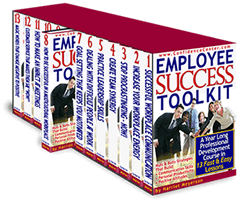 Professional development is essential to your employees’ success. It’s also essential to high employee morale because people who know how to deal effectively with workplace challenges are happier, less stressed, and more productive.
Professional development is essential to your employees’ success. It’s also essential to high employee morale because people who know how to deal effectively with workplace challenges are happier, less stressed, and more productive.
Obviously, when you first hire employees they have to be trained. What happens after that? Does your company offer ongoing training? If so, you are making your employees more valuable to your company or organization.
Professional Development boosts employee morale.
When you give employees professional development, you are demonstrating that you have their best interests at heart. That supportive feeling raises employee morale. Happy employees are more productive and will go the extra mile for you.
It creates company loyalty
If you are worried that all that training will be lost if the employee leaves… Remember, the only thing worse than training an employee and having them leave, is not training them and having them stay.
The process of professional development is exciting, and your employees will be happy that they are learning skills that will help them in the future. Employees will be grateful to you and your company. They may stay with your company because of the ability to grow and develop.
What if employees already know how to do their jobs? What should you teach?
While the job, itself, may not require ongoing training, there are many ways you can help grow your employees.
You can train them to be better communicators, to have a more positive attitude, to be a better team member, etc. These are known as the “soft skills.” Unfortunately, the word, “soft” makes them seem unimportant, which is not true.
“Soft Skills” make employees more successful
Actually “soft skills” skills are very important because they make employees stronger, more confident, and more effective. These are the skills that help employees handle day-to-day work situations with maturity and competence. And, if that’s not enough, these results will raise employee morale. Teaching these skills is different from teaching a computer program, because they involve personality change.
Therefore, they can’t be taught in a one-day session. When it comes to “soft skills,” employees have to “Live their learning” by using the skills every day at work.
This means that you need to teach them in bite size pieces so employees have one strategy to practice at a time. If you teach too many things at once it becomes overwhelming and ineffective.
Employees need to practice one strategy at a time so they become aware of it’s usefulness and comfortability using it. With practice each skill or strategy will become integrated into their personalities and seem natural.
Example: One communication strategy
For example, suppose you want your employees to be more positive. You can teach them the following positive words to substitute for negative words.
- Instead of “Problem” use the word “Situation or Challenge” (It changes the focus to the solution.)
- Instead of “But” use the word “And” (The word “but” when used in the middle of a sentence, discounts the first part of the sentence. “I like your report, but it’s missing…” becomes “I like your report, and would you please add…”)
- Instead of “Always and Never” use the words “Often and Rarely” because absolutes are rarely true so using them can cause people to discount what you are saying.
There are many words that emit negative feelings, and while you can’t change people’s vocabulary over night, if you do one word a week, pretty soon you will see the positive words popping up when employees talk to you and to each other.
This is just one example of the many professional development “soft skills” you can teach your employees. Here are the other essential skills.
13 Professional Development “Soft Skills” that make employees successful
1. How to have “Successful Workplace Communication” so that there are no mixed messages that cause mistakes or hard feelings.
2. How they can increase their own “Workplace Energy” so they can be more productive.
3. How to “Stop Procrastinating” so the difficult work gets done on time.
4. How to “Create Team Synergy” so they get along better with their co-workers and get more accomplished.
5. “Leadership Skills” because employees who know how to lead, are more effective at following.
6. How to “Deal With Difficult People at Work” because if they have a strategy for dealing with difficult co-workers, they will feel empowered and less stressed.
7. “Goal Setting” because they need to keep motivated in the right direction until their goals are completed.
8. How to become accepting in a “Multicultural Workplace” so that everyone not only gets along, but also appreciates each other.
9. “Active Listening” avoids misunderstandings. With active listening strategies you know they have understood what you said.
10. How to “Thrive in a Stressful Workplace” so that day-to-day stressful situations don’t lower employee productivity.
11. How to “Make an Impact at Meetings” so they will add value to your meetings.
12. “Customer Service” because without happy customers your company won’t be successful.
13. How to “Change Negative to Positive” so that your workplace becomes a joy to work in.
How to get started, even if you don’t have lots of time
If this list seems overwhelming, don’t worry, you take a year to go through it. One step at a time makes it easy for your employees to learn and incorporate the skills into their workdays. Do a new topic every 4 weeks or once a month.
Take 15 to 20 minutes to introduce a new topic at a meeting. Present a few strategies that are most important to you, and discuss ways that it can improve your workplace and raise employee morale.
Remember, it is better to practice a few strategies than to get overwhelmed with too many.
Your job as a supervisor or manager will be easier when you develop your employees one step at a time. Your employees will be happier, have a more positive attitude, and they will be more productive. More effective employees make a more successful company.
Where to get the materials for your training
 No need to spend countless hours researching each topic and creating your own lessons. We have created the 13 lessons for you in the Employee Success Toolkit course. They are complete with PowerPoint slides, written lessons, and follow up lessons.
No need to spend countless hours researching each topic and creating your own lessons. We have created the 13 lessons for you in the Employee Success Toolkit course. They are complete with PowerPoint slides, written lessons, and follow up lessons.
What’s more, the course is very flexible, so you can choose the way you give the lessons that best fits your workplace structure.
- Take as little as 20 minutes at a monthly meeting and follow up mid-month.
- Use as a platform for discussing your workplace problems and how to use the lesson to solve them.
- If you don’t have meetings, or are in different locations, you can distribute written lessons by email, and follow up via email and phone conferences.
The lessons are short – approximately 3 pages – of practical workplace succes strategies, and have written goal setting and follow up forms so that your employees can focus on one topic for the entire month.
A bonus Instructor’s Manual takes you step-by-step through easy ways to present the lessons.
Free Quiz – How Do You Rate as a Leader?
I invite you to fill in the blue box below for free leadership tips and your Leadership Survey. Then look for the confirmation email and click on the link in it to confirm.